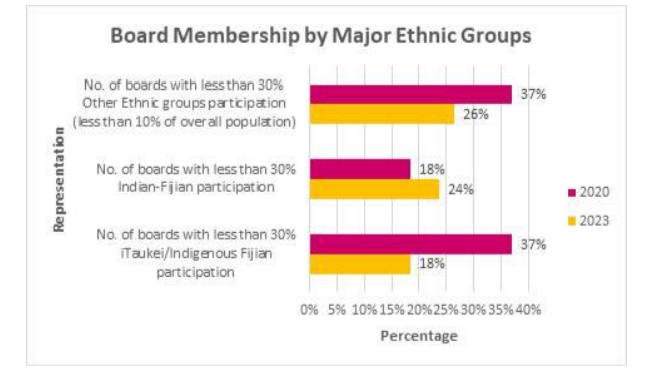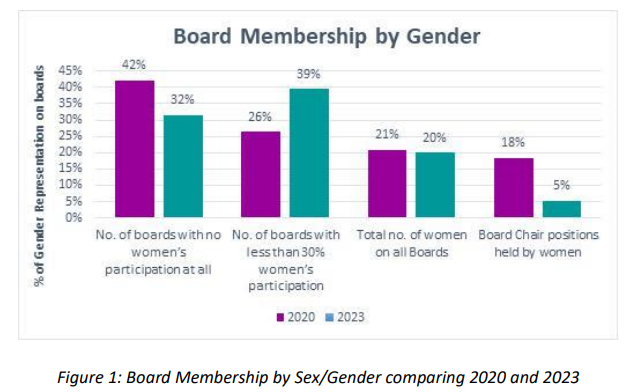Women’s participation in State Boards and Commissions has worsened slightly overall despite promises made by the Coalition government to strongly promote women’s rights.
Recent appointments include all-male representatives in some of the boards – Land Transport Authority (LTA), Fiji Roads Authority (FRA), Amalgamated Telecom Holdings Limited (ATH), Fiji Revenue and Customs Service (FRCS), and Fiji Sugar Corporation (FSC).
The only overall improvement has been for indigenous Fijian males.

Women have been overlooked again despite numerous confirmed applications made by qualified women for board positions.
Gender Equality in national governance
With the recent change in leadership at the national level in Fiji, there was an optimistic outlook for a reasonable increase in women’s participation in leadership, for example on national governance boards.
Fiji Women’s Rights Movement (FWRM) strongly believes that by prioritizing women’s leadership in all spaces, one of which is board appointments, some progress can be made in achieving gender parity in Fiji.
It is meaningless to say that there should be an overall 30% representation of women on all boards in total.
This makes women’s participation in leadership an illusion. Genuine leadership means participation in all Boards, and all sectors.
This approach recognizes the importance of meaningful participation and equal opportunities for women in decision-making processes across all sectors. FWRM managed to obtain updated data on 27 out of the 38 state owned enterprises, originally covered in its 2020 survey and analysis despite the lack of information on websites, through media articles and the government’s official pages.
It conducted a rapid gender assessment to analyse the advancement or decline of women’s representation on boards in Fiji, since 2020 and the advent of the new Coalition government.
FWRM is open to changing its assessment if updated current data is provided showing that the global target of 30% women in all Boards has been reached. In July 2021 the estimated population was 939,535 with indigenous Fijians or i-Taukei at 56.8% Indian-Fijian at 37.5%, Rotuman at 1.2%, and others at 4.5%.
Since September 2020 when FWRM first reported on women on boards it appears that there has been little change in the representation of women in leadership positions, particularly on State-Owned Enterprise (SOE) boards. The 2023 research reveals that women’s representation on boards remains stagnant at 20%, in fact slightly worsening from 21% in 2020.

As a further demonstration of the limited participation of women in Fiji’s leadership, only 2 of 38 Board Chair positions are held by women, or 5%, showing a significant worsening since 2020, from 18% to 5%.
Ethnic Diversity
Of the 211 members in 38 enterprises, indigenous Fijians comprise 95 (45%), the percentage for Indian Fijians has dropped to 38% from 53% and other ethnics groups is at 17%, increasing by 1% from 2022. The overall drop in the number of Indian Fijians and the increase in the numbers of indigenous Fijians is reasonable relative to their numbers in the population.
The problem however is gender parity. Some 3 or 8% of boards have no indigenous Fijian participation at all, and 7 or 18 % of Board have less than 30% indigenous Fijian participation. In comparison the number of Boards with no Indian- Fijian participation is 4 of 38 or only 11%, and the number of Boards with less than 30% Indian-Fijian participation is 9 of 38 or 24%.
Overall, there has been a significant improvement in the number of indigenous Fijian males on boards, privileging this group over indigenous Fijian women, as well as over all women of other ethnicities. The most privileged group on boards overall, however, are men of other ethnic groups, neither indigenous nor Indian-Fijian, proportionate to their population size. Although the population of other groups is 4.5% they hold 17% of Board positions, the majority of whom are men.
The Bottom Line
The bottom line is that nothing much has changed for women on boards overall in the last 3 years nor since the 2022 elections. In 2020 the most privileged group on Boards was men, and it is still the case 3 years later. This is despite the significant evidence that more women on Boards promote better governance, greater profits, and less corruption.
By not actively promoting and supporting the inclusion of women on boards, Fiji has lost the opportunity to harness the diverse perspectives, talents, and expertise that women bring to the table. This inclusive approach would have fostered less corruption, better governance, enhanced organizational effectiveness, and ultimately contributed to a more equitable and prosperous society.
The underrepresentation of women in board positions in Fiji is attributed to societal norms, gender biases, limited access to professional development, discriminatory practices in recruitment, and cultural expectations around family responsibilities.
FWRM stands firm in its commitment to advocating women’s leadership and encourages the government and relevant stakeholders to seize this opportunity to create real change by increasing women’s representation on boards and empowering them to make impactful contributions at all levels of decision-making.